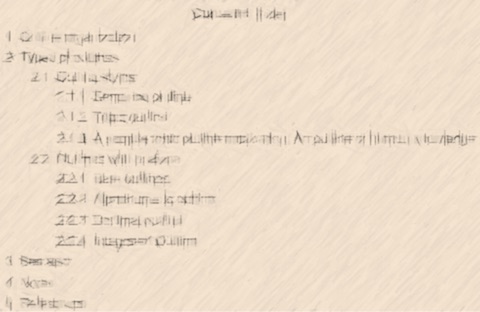Your outlines are useless. You need a fat outline.
 When you’re planning to write, but before you’re actually writing, you create an outline. Unfortunately, most outlines are worthless. You need a better outline: a fat outline.
When you’re planning to write, but before you’re actually writing, you create an outline. Unfortunately, most outlines are worthless. You need a better outline: a fat outline.
Outlines are helpful for mapping out the structure of a long piece of writing — anything more than 1,000 words (a couple of pages). An outline ought to help the people you’re working with — your boss, your clients, your editor — to understand what you’re going to write. It should also force you, the writer, to think clearly about content.
The problem is, traditional outlines don’t do this very well.
For example, here’s an outline of a the first 20% of my book:
Writing Without Bullshit
Part I: Why Writing Without Bullshit Matters
Chapter 1: Getting Beyond Bullshit
The Iron Imperative
Measuring meaning
One woman’s path to success
Could this be you?
Join me on a journey of clarity and candor
Chapter 2: Where Bullshit Comes From
We spend all day reading on screens
No one edits what we read
We learned to write the wrong way
Fear is at the heart of bullshit in writing
So, is this going to be good? No one could possibly know. As a tool for sharing content ideas, a traditional outline is poor. It’s like looking at the skeleton of a potential blind date and trying to figure out if you think they’re attractive. You need some meat on the bones.
That’s one reason that I came up with the concept of a “fat outline.” A fat outline is more like a “treatment” for a movie — it includes pieces of the actual content. It flips between writing that will potentially be in the final piece, descriptions of potential content, and promises. It’s harder to write than a traditional outline because you have to think about it, but it’s much better for starting conversations.
When writing a fat outline, you can ignore grammar and any other traditional writing rules (and outlining rules), because you’re just showing how you’ll organize the content. Editors can critique that organization, but shouldn’t word-edit. For example, here’s a fat outline for the first part of my book.
Writing Without Bullshit
Part I: Why Writing Without Bullshit Matters
This part analyzes the trends that generate bullshit, as a preliminary to the actual writing advice.
Chapter 1: Getting Beyond Bullshit
The tide of bullshit is rising. Your inbox is full of . . . a cri de ceour to tap into the reader’s outrage. Promise that if you read the book and learn to write boldly you’ll stand out. I will give you the courage to say what you mean.
The Iron Imperative Definition: You must you treat the reader’s time as more valuable than your own. Explain why people tend not to do this. Adopt the Iron Imperative or put the book down.
Measuring meaning Define bullshit. Define the “meaning ratio:” meaningful words out of total words. Calculate for Inovalon description; show alternative.
One woman’s path to success Tell the story of Darlene, entrepreneur who succeeded with candor and boldness. Include sample of her email.
Could this be you? More stories, including Tom (agency guy), Larry (rose from tech support to PR), Ellen (owned computer store, career as writer/editor).
Join me on a journey of clarity and candor Lay out the sections and chapters in the rest of book.
Chapter 2: Where Bullshit Comes From
Quotes from William Zinsser and Harry Frankfurt for historical perspective. Then lay out four reasons we’re drowning in clutter.
We spend all day reading on screens Smartphone owners spend 3.3 hours per day on their screens (Salesforce.com), half of phone users use them in bathroom (Forrester), those under 70 more likely to read media online than in print (Forrester). Ben Horowitz: “Babies born today will probably never read anything in print.” Chartbeat data on how most people don’t read very far into a given news story. . . . .
When you write a fat outline, you can have a meaningful conversation about structure with an editor — before you’ve put in all the work of writing sentences and paragraphs. So next time you write something substantial, leave the skinny-bones outlines behind. Do a fat outline first. You’ll waste a lot less of the editor’s time — and your own.
This might interest you: https://hbr.org/1998/05/strategic-stories-how-3m-is-rewriting-business-planning
Yes, that article is very much related to my point here — that spare bullet points carry very little meaning payload.
Love the “fat” outline concept. Could be very useful in my writing work. Thanks for the post.
Rich
Thanks for this. I like the idea of a fat outline, and might refer authors here in the future. In my editing work I see a lot of material that I’m pretty sure had no outline at the start, let alone a good one. The fat outline idea reminds me of the information plan and content plan stages I learned about for technical writing, where the latter is a fleshed out version of the former. With a good content plan, writing is a cinch.